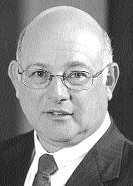By Di Freeze
Ronald D. Sugar assumed his role as CEO of Northrop Grumman Corporation, the nation’s second largest defense contractor, on April 1. A 35-year defense industry veteran, he retains his position as company president.
“Ron Sugar is a talented and seasoned executive who possesses a thorough understanding of our business, our strategy and our potential,” said Kent Kresa, former CEO and chairman, who has retired, after reaching the board’s mandatory retirement age of 65 for senior executives, but will continue as non-employee chairman until Oct. 1, 2003.
“Since arriving at Northrop Grumman after our April 2001 acquisition of Litton Industries, Ron and I have worked closely together,” he continued. “He has distinguished himself throughout the organization as a strong manager with an uncompromising commitment to excellence. Under his leadership, Northrop Grumman will be in very capable hands and will continue on a steady and consistent course.”
On March 13, Sugar, 54, spoke about twenty-first century defense technology and its role in America’s security in a Town Hall address in Los Angeles. At that time, Sugar told a little of his history, saying that as a boy, he lived in Hawthorne, Calif., in the “shadow of the old Northrop factory.”
“I always wondered what they did in there. Now I know,” he said.
In his speech, Sugar said, “The present Northrop Grumman is not the one your father or your grandfather knew,” and told a little of the company’s history.
“We began life in 1939 in Hawthorne as Northrop Corporation, founded by the legendary aircraft designer Jack Northrop,” he said. “Over most of our history, we’ve been known as an innovative airframe manufacturer, associated since the 1980s, for example, with the pioneering B-2 stealth bomber.”
However, said Sugar, in the early 1990s, the company changed direction.
“Adjusting to the reality of a shrinking market for military aircraft, we began building strength in new technologies that we thought would be central to America’s defense needs in the twenty-first century,” he said.
Sugar said that through 16 strategic acquisitions of the company—including leading companies like Grumman, Westinghouse, Logicon, Litton Industries, Newport News and TRW—as well as internal research and development, Northrop has significantly gained capabilities in defense electronics, information technology and systems integration.
“And we extended our expertise from aircraft to platforms in every military domain, from undersea to outer space—a change that probably would amaze someone familiar with the old Northrop Corporation,” he said. “We now produce nuclear aircraft carriers, attack submarines, destroyers, unmanned surveillance vehicles, airborne lasers and even the next-generation satellite telescope that will replace the Hubble.”
Today, Northrop Grumman Corporation, headquartered in Los Angeles, employs 120,000 people in operations in all 50 states and 25 countries, and expects to have revenues this year of $25 billion.
Ron Sugar
In 1968, Sugar graduated summa cum laude in electrical engineering from the University of California at Los Angeles, where he also received master’s (1969) and doctoral degrees (1971) in the same field. In 1996, he was honored by his alma mater as alumnus of the year. He has completed executive education programs at Stanford University, the Wharton School of the University of Pennsylvania and Harvard University.
Before joining Northrop Grumman in 2001, Sugar held technical and management positions with Hughes Aircraft Co., Argosystems Inc. and the Aerospace Corporation, and spent nearly 20 years with TRW. He served as president and COO of TRW Aerospace and Information Systems, and as a member of the chief executive office of TRW Inc. He also served as chief financial officer and executive vice president and general manager of TRW’s global automotive electronics business, and at one time as vice president of TRW Space Communications Division. At Litton, he served as president and COO and as a member of the board of directors.
Elected president and COO of Northrop Grumman in September 2001, he is a member of the office of the chairman, which is responsible for the total operations of the corporation, and serves as a member of the Northrop Grumman board of directors.
Kent Kresa
Born in New York City and raised on Long Island, Kent Kresa received his education at the Massachusetts Institute of Technology, earning a bachelor’s degree in 1959 and post-graduate degrees in 1961 and 1966, all in aeronautics and astronautics.
From 1961-68, he was associated with the Lincoln Laboratory at M.I.T., where he worked on ballistic missile defense research and reentry technology. After serving with the Defense Advanced Research Projects Agency, where he was responsible for broad, applied research and development programs in the tactical and strategic defense arena, Kresa joined Northrop Grumman in 1975 as vice president and manager of the company’s Research and Technology Center, developing new proprietary processes and products.
From 1976-82, he served as corporate vice president and general manager of the Ventura Division, a leader in the production of unmanned aeronautical vehicles.
In 1982, he was appointed group vice president of the company’s Aircraft Group and in 1986 was named senior vice president, technology development and planning. He was elected president of the company in 1987, CEO of Northrop Grumman in January 1990, and chairman of the board in September 1990.
During his tenure at DARPA, Kresa received the Secretary of Defense Meritorious Civilian Service Medal in 1974, as well as the Navy’s Meritorious Public Service Citation and the Arthur D. Flemming Award, as one of the top 10 people in the U.S. government, both in 1975. He received the Air Force Association’s John R. Alison Award for Industrial Leadership in 1994, and the Navy League of New York’s Admiral John J. Bergen Leadership Award in 1995.
In 1996, the California Museum of Science and Industry and the California Museum Foundation honored Kresa as California Industrialist of the Year, and in 1998, the American Institute of Aeronautics and Astronautics honored him as an Honorary Fellow.
In 2001, “BusinessWeek” selected Kresa as one of the nation’s top 25 managers. That same year, he received the Private Sector Council’s Leadership Award for his commitment to improving governmental efficiency.
In May 2000, the Aerospace Historical Society presented Kresa with the International von Kármán Wings award for his contributions to the industry, and in March 2000, the California Manufacturers and Technology Association named Kresa/Northrop Grumman as Manufacturer of the Century.
“Forbes” magazine named Northrop Grumman its Company of the Year for 2002. In January 2003, the Aero Club of Southern California honored Kresa with the 2002 Howard Hughes Memorial Award. Recognized for his significant contributions to the advancement of aviation and space technology, Kresa is the 24th recipient of this prestigious award. The first award, in 1978, was presented to Jack Northrop.
On March 13, 2003, California Senator Dianne Feinstein delivered a tribute to Kresa from the floor of the U.S. Senate. Among her remarks, Feinstein said, “Under his guidance, Northrop Grumman grew from a mid-sized defense company known primarily for aircraft building to a full-spectrum major defense firm.”
In her recounting of Kresa’s accomplishments, Feinstein said that for more than 42 years he worked relentlessly in “pushing for greater innovation, efficiency and readiness with our great nation’s defense establishment,” and mentioned that he was “instrumental in developing and gaining Congressional approval for several key platforms that will help form the backbone of our 21st century military.”
“These include the Joint Strike Fighter, the DDX family of destroyers, cruisers and littoral combat ships, and the new generation of Coast Guard ships and aircraft known as the Deepwater project,” she said.
“My office will remember Mr. Kresa for his loyalty, dedicated service, and accomplishments, and we thank him,” she concluded.
For more information, visit [http://www.northropgrumman.com]












